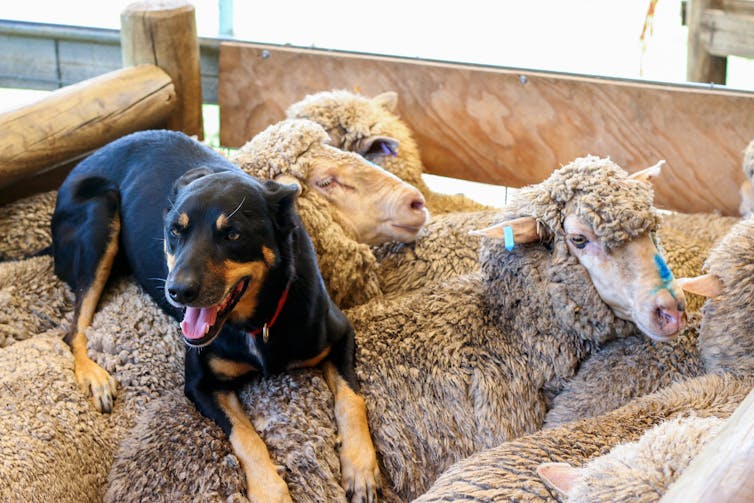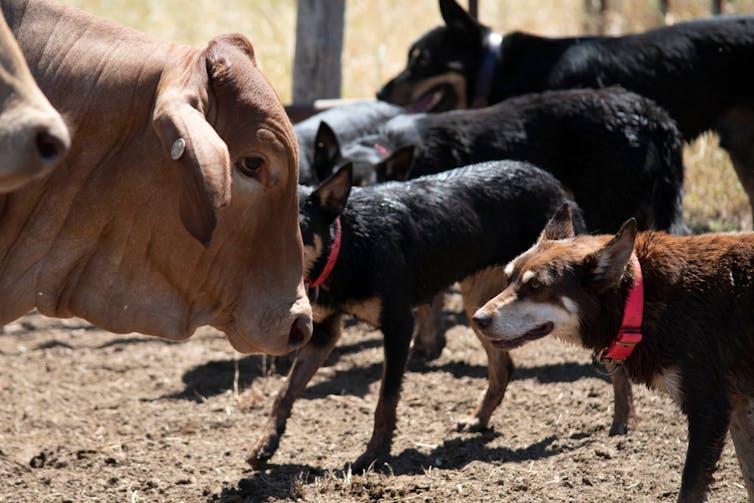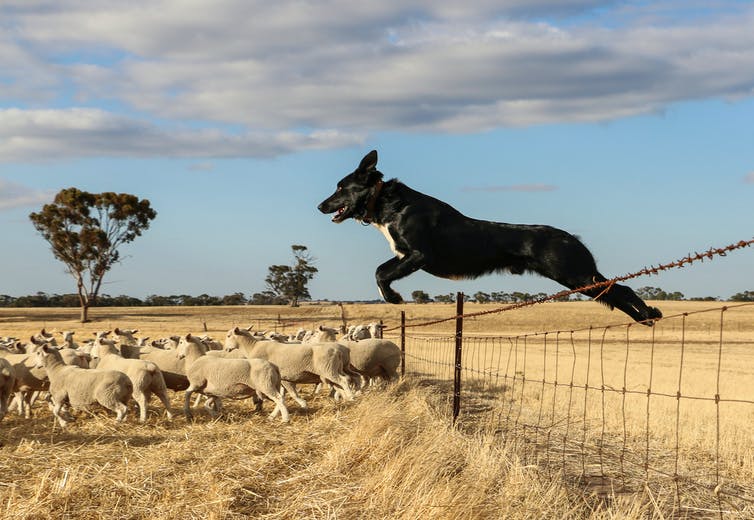Melissa Starling and Claire Wade, University of Sydney.
The recent ABC TV series Muster Dogs has brought into sharp focus the incredible skills of our working stock dogs.
It’s not just their sensitivity to livestock movement that makes them so good at what they do.
They are also agile endurance athletes that can work long hours in very hot conditions. During peak times, working kelpies have been recorded travelling over 60km just in one work day.
There are dog breeds all over the world that have been selectively bred over many generations to work with stock. That selective breeding has shaped them to be best suited to the specific environment they work in and the style of work they are required to do.
If you’re interested in the history, traits and skills of these amazing dogs – and perhaps have wondered about owning one yourself – here’s what you need to know.
Shaped for Australian conditions
The Australian Working Kelpie was shaped for Australian conditions to use what’s known as a “strong-eyed style” of herding, which is to adopt a low posture and use eye-stalking (keeping its eyes fixed on the livestock) to track the herd’s movement. The Border collie also uses this style.
They control the movement of the herd with exquisite sensitivity with their overall presence.
Their behaviour includes that characteristic stalking posture with head and body low, and quiet, controlled steps.
This is how a predator would approach a herd of prey animals if it were hunting.
The strong-eyed herding dog stalks, stares, holds position, and rushes; it is not just where they are that controls the herd, but what they are doing.
Most other herding breeds have a looser style of herding, where they work with their heads up and use their body position to influence the movement of the herd.
Herding dogs that use eye-stalking also often work the front of the herd, turning it towards the handler. The looser style herding dogs tend to drive the herd from the rear.

Bred for bravery
Australian Working Kelpies were developed from British farm collies in the late 1800’s.
Some claim there is dingo infused in the breed to add resilience, but this remains subject to debate.
Signals of selection in the Australian Working Kelpie DNA suggest one very important trait is the ability to withstand prickly terrain; a working dog that cannot ignore burrs and spines to continue working is of little use to the farmer.
Other traits prized by the handlers are bravery and a level head. In other words, a dog that doesn’t panic under pressure.
Unlike many other herding breeds, the Kelpie is often asked to work independently from the handler and to think for itself.

Owning a working dog
Working breeds can be very rewarding canine companions for people that don’t have stock for them to work. But prospective owners need to understand the selective breeding that makes these dogs so good at herding can also make them a handful in a suburban setting.
They are of course extremely active; most need a few hours of high intensity exercise a day just to keep them from destroying the home and yard when they are young.
They are also highly alert and often extremely aroused by movement. The faster and more chaotic the movement, the more powerfully they are drawn to control that movement as they would a herd.
This can make playing with kids, ball games, bikes and skateboards, and even encountering other dogs in the dog park a real challenge.
Working breeds also sometimes have a tendency to rush in and bark at an object that is bothering them, just as they would rush and bark at cattle looking to break away from the herd.

Some good lessons for owners
The television program Muster Dogs presented some core messages applicable to any pet dog, as well as working dogs that are pets at home. These include:
1. Early exposure
Ensuring puppies have positive experiences with stimuli they’ll encounter often in life early is crucial. They must be taught to accept activities they need to be tolerant of, and be comfortable with handling and restraining themselves.
2. Responsiveness
The owner must build strong foundations in the areas of coming when called, staying close while off leash, and maintaining a connection with the handler even around distractions.
3. Impulse control
This is particularly important for working dogs keen to participate in exciting activities. In fact, all dogs can benefit from learning to control their impulses and not chase, jump up, or use their mouth every time the urge takes them.
It takes a special kind of dog to be able to face animals 20 or more times their size that can easily cause them serious damage.
To do it all day in the hot and rough terrain of inland Australia takes a dog with a tremendous desire to work.
This should never be forgotten by those of us living in more comfortable environments when we think we want a working dog to accompany us through our suburban lives.
Melissa Starling, Postdoctoral researcher, University of Sydney and Claire Wade, Professor, Chair of Computational Biology and Animal Genetics, University of Sydney
This article is republished from The Conversation under a Creative Commons license. Read the original article.
